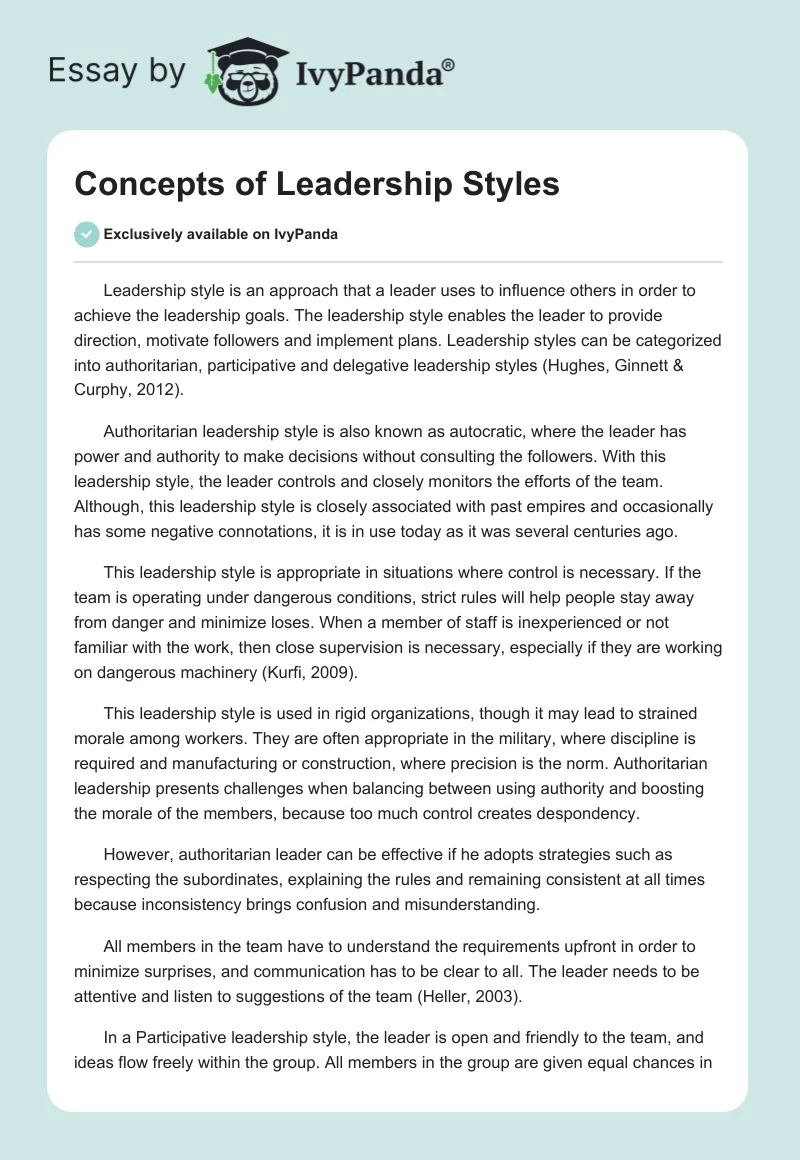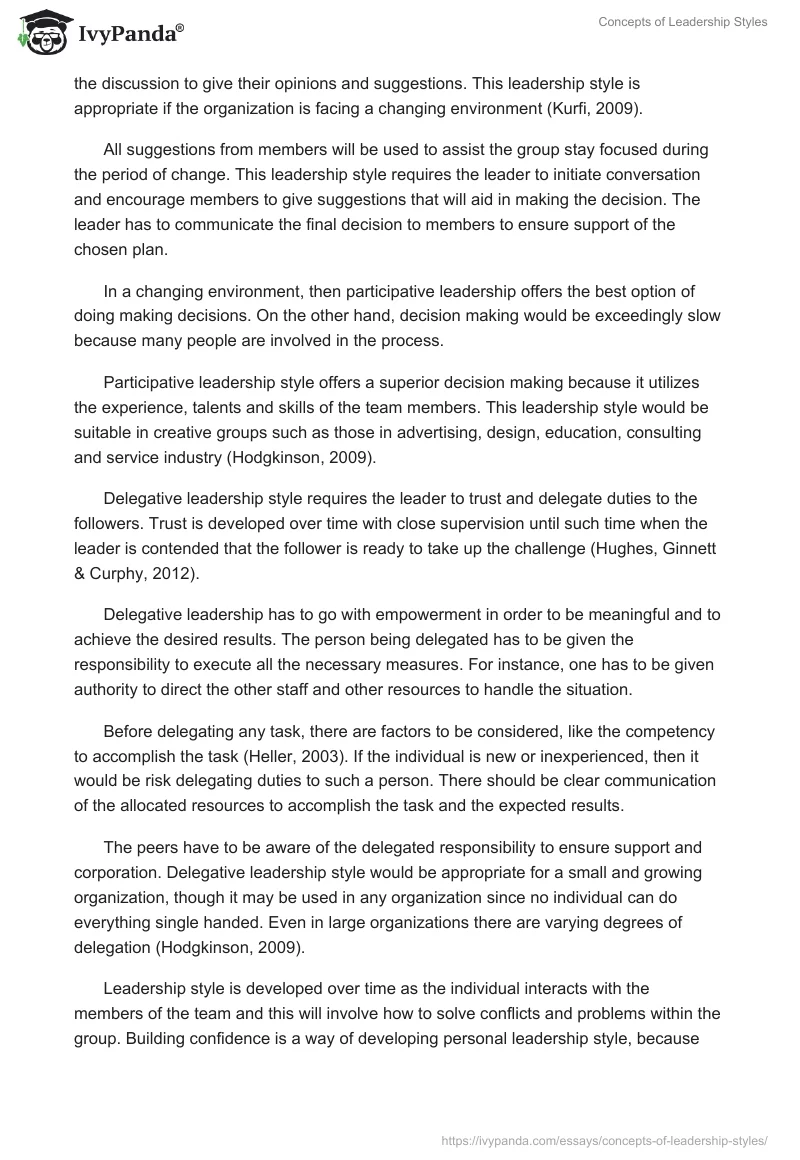Leadership style is an approach that a leader uses to influence others in order to achieve the leadership goals. The leadership style enables the leader to provide direction, motivate followers and implement plans. Leadership styles can be categorized into authoritarian, participative and delegative leadership styles (Hughes, Ginnett & Curphy, 2012).
Authoritarian leadership style is also known as autocratic, where the leader has power and authority to make decisions without consulting the followers. With this leadership style, the leader controls and closely monitors the efforts of the team. Although, this leadership style is closely associated with past empires and occasionally has some negative connotations, it is in use today as it was several centuries ago.
This leadership style is appropriate in situations where control is necessary. If the team is operating under dangerous conditions, strict rules will help people stay away from danger and minimize loses. When a member of staff is inexperienced or not familiar with the work, then close supervision is necessary, especially if they are working on dangerous machinery (Kurfi, 2009).
This leadership style is used in rigid organizations, though it may lead to strained morale among workers. They are often appropriate in the military, where discipline is required and manufacturing or construction, where precision is the norm. Authoritarian leadership presents challenges when balancing between using authority and boosting the morale of the members, because too much control creates despondency.
However, authoritarian leader can be effective if he adopts strategies such as respecting the subordinates, explaining the rules and remaining consistent at all times because inconsistency brings confusion and misunderstanding.
All members in the team have to understand the requirements upfront in order to minimize surprises, and communication has to be clear to all. The leader needs to be attentive and listen to suggestions of the team (Heller, 2003).
In a Participative leadership style, the leader is open and friendly to the team, and ideas flow freely within the group. All members in the group are given equal chances in the discussion to give their opinions and suggestions. This leadership style is appropriate if the organization is facing a changing environment (Kurfi, 2009).
All suggestions from members will be used to assist the group stay focused during the period of change. This leadership style requires the leader to initiate conversation and encourage members to give suggestions that will aid in making the decision. The leader has to communicate the final decision to members to ensure support of the chosen plan.
In a changing environment, then participative leadership offers the best option of doing making decisions. On the other hand, decision making would be exceedingly slow because many people are involved in the process.
Participative leadership style offers a superior decision making because it utilizes the experience, talents and skills of the team members. This leadership style would be suitable in creative groups such as those in advertising, design, education, consulting and service industry (Hodgkinson, 2009).
Delegative leadership style requires the leader to trust and delegate duties to the followers. Trust is developed over time with close supervision until such time when the leader is contended that the follower is ready to take up the challenge (Hughes, Ginnett & Curphy, 2012).
Delegative leadership has to go with empowerment in order to be meaningful and to achieve the desired results. The person being delegated has to be given the responsibility to execute all the necessary measures. For instance, one has to be given authority to direct the other staff and other resources to handle the situation.
Before delegating any task, there are factors to be considered, like the competency to accomplish the task (Heller, 2003). If the individual is new or inexperienced, then it would be risk delegating duties to such a person. There should be clear communication of the allocated resources to accomplish the task and the expected results.
The peers have to be aware of the delegated responsibility to ensure support and corporation. Delegative leadership style would be appropriate for a small and growing organization, though it may be used in any organization since no individual can do everything single handed. Even in large organizations there are varying degrees of delegation (Hodgkinson, 2009).
Leadership style is developed over time as the individual interacts with the members of the team and this will involve how to solve conflicts and problems within the group. Building confidence is a way of developing personal leadership style, because people always underestimate their abilities. Lack of self assurance is an impediment to developing leadership style.
The best way to build confidence is through speaking in different meetings and asking relevant questions, which serves as a way of knowledge acquisition and gaining self confidence (Hodgkinson, 2009). Communicating ideas to others will increase the credibility, visibility and recognition from the members of the group. Individual leadership style is also developed through observation from others.
People will learn and adopt leadership styles from their role models, for example, a young leader will adopt leadership style from another leader he perceives as an exemplary leader who may have brought success to the team (Heller, 2003). This is one the most effective ways to understand which type leadership style will work for the individual.
Once the observed leadership style is put into practice through trial and error, it is finally perfected and fully adopted by the individual as one’s leadership style.
Different circumstances may lead to change of leadership style, for instance, leadership style in a small organization may differ with the leadership style in a large organization. If the organization changes its core business activities, it may require a different leadership style to match the requirements of the new business environment (Kurfi, 2009).
My leadership style is participative, which involves all the members in the group when making a decision, and there are advantages associated with this leadership style. When all members are involved in decision making process, there is a sense of ownership and participation from members.
This could translate into higher productivity because everybody would be glad to witness the success of decisions they made. This leadership style serves as a motivation to the whole group because professional skills of all members are utilized and, therefore, giving members greater job satisfaction (Hodgkinson, 2009).
However, there are challenges in this leadership style, which include slowing down the process of decision making. The inputs and feedback flow back and forth among members before finally making the decision.
There are security issues because members who are privy to sensitive information within the organization could easily leak out the information to competitors. Despite the shortcomings, the advantages of participative leadership outweigh its disadvantages (Heller, 2003).
Reference List
Heller, F. A. (2003). Managerial decision-making: A study of leadership styles and power- sharing among senior managers organizations, people, society. Washington, DC: Taylor & Francis.
Hodgkinson, J. (2009). Leadership styles for program and project managers. Retrieve from web.
Hughes, R.L. Ginnett, R.C., & Curphy, G.J. (2012). Leadership: Enhancing the lessons of experience (7th ed.). New York, NY: McGraw-Hill Irwin.
Kurfi, A. K. (2009). Leadership styles: The managerial challenges in emerging economies. International Bulletin of Business Administration. Web.


